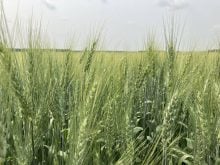Some of Canada’s hard red spring wheat buyers are tired of paying big premiums compared to what they pay for lower classes of wheat.
However, they are preparing to swallow more big spreads between Canada Western Red Spring (CWRS) wheat and hard red winter (HRW) and soft red winter (SRW) wheat.
“I think the problem really will be the quality,” Estefania De Vera, vice-president for purchasing at Philippines miller Pilmico, said during a visit to the Canadian International Grains Institute.
Read Also

Why feds imposed EV tariffs
Moe and Kinew have a fight on their hands when it comes to eliminating the EV tariff. Canada has to worry about pissing off the U.S. and Mexico and hundreds of thousands of auto workers.
“I think that will be a problem if that really continues, if the harvest really will be that bad, if that will really happen, then the prices will really be (high) on the high protein level.”
Alfredo Castillo Montero of the Mexican milling company Comercializadora Portimex agreed.
“In the medium term … maybe protein will be expensive, maybe normal wheat will be cheaper, so we will be increasing the spread.”
Montero and De Vera said they are glad of large global wheat carryout going into 2010-11, but they grimace at having to pay the premiums that CWRS and U.S. Dark Northern Spring can command.
Montero said quality high protein wheat receives a 30 to 40 cents per bushel premium to winter wheat.
“That’s a very big spread,” he said.
“Normally you have 10 cents, 12 cents, five cents. Twenty cents was too much. Right now you have 30 cents in that kind of stuff.”
However, Montero and De Vera said they accept premiums because their customers will pay for quality bread.
The millers were in Winnipeg to attend a CIGI course for foreign grain buyers teaching them about Canada’s quality control and grading systems and the best ways to blend expensive quality Canadian grain with cheaper, lower quality foreign grain.
Montero said he can’t stick with a permanent blend because crop conditions vary from year to year.
For instance, he said American HRW wheat appears to be poor quality and dirty this year, which means he’s likely to reduce it and increase the amount of hard red spring and SRW.
“We will not buy too much HRW for the next year and the rest of this year,” he said.
“We will buy only CWRS and SRW because HRW is having bad timing for quality in the U.S.… They are having a lot of problems.”
De Vera said clean, insect-free grain is an advantage for her company.















